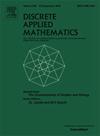Unitary Cayley graphs of finite semisimple rings
IF 1
3区 数学
Q3 MATHEMATICS, APPLIED
引用次数: 0
Abstract
Let be a finite ring with identity . The unitary Cayley graph of , denoted by , is a graph whose vertices are elements of and are adjacent if and only if is a unit in . A ring is called a -ring if for any ring such that , then . In this paper, we study unitary Cayley graphs of finite semisimple rings and show that finite semisimple rings of the form where for all are -rings. We achieve this by using the Cartesian skeleton of the graph to show that is prime with respect to the direct product and deduce the result through the uniqueness of graph factorization. In addition, we show that any finite commutative reduced ring is a -ring by combining graph cancellation properties with combinatorial arguments on the eigenvalues of the unitary Cayley graph of finite semisimple rings. The two results imply that if and are rings such that and does not contain the factor or is a product of fields, then .
有限半单环的酉Cayley图
设R是一个单位元1≠0的有限环。R的酉Cayley图,用GR表示,是一个顶点是R和x,y的元素相邻的图,当且仅当x - y是R中的一个单位时,环R称为du环,如果对于任何环S满足GR = GS,则R = S。在本文中,我们研究了有限半单环的酉Cayley图,并证明了形式为Mn1(Fq1) x⋯×Mnk(Fqk)的有限半单环,其中对于所有i∈{1,…,k}, Mni(Fqi)≠F2是du环。我们利用图的笛卡尔骨架证明了GMn(Fq)对于直积是素数,并通过图分解的唯一性推导出结果。此外,通过结合有限半单环的幺正Cayley图的特征值上的组合参数,证明了任意有限交换约化环是一个du环。这两个结果表明,如果R和S是环,使得GR = GS和R/JR不包含因子F2或R/JR是域的乘积,则R/JR = S/JS。
本文章由计算机程序翻译,如有差异,请以英文原文为准。
求助全文
约1分钟内获得全文
求助全文
来源期刊

Discrete Applied Mathematics
数学-应用数学
CiteScore
2.30
自引率
9.10%
发文量
422
审稿时长
4.5 months
期刊介绍:
The aim of Discrete Applied Mathematics is to bring together research papers in different areas of algorithmic and applicable discrete mathematics as well as applications of combinatorial mathematics to informatics and various areas of science and technology. Contributions presented to the journal can be research papers, short notes, surveys, and possibly research problems. The "Communications" section will be devoted to the fastest possible publication of recent research results that are checked and recommended for publication by a member of the Editorial Board. The journal will also publish a limited number of book announcements as well as proceedings of conferences. These proceedings will be fully refereed and adhere to the normal standards of the journal.
Potential authors are advised to view the journal and the open calls-for-papers of special issues before submitting their manuscripts. Only high-quality, original work that is within the scope of the journal or the targeted special issue will be considered.
 求助内容:
求助内容: 应助结果提醒方式:
应助结果提醒方式:


